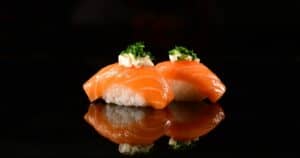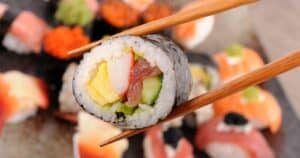Ever wondered what makes nigiri sushi so special? It’s not just any sushi. Nigiri is a type of sushi where a slice of fish or seafood sits on top of a small mound of rice. It’s simple yet delicious, and there are so many types to explore.
Classic combinations that never go out of style
Nigiri sushi is special because it has a slice of fish or seafood on top of rice. You can find many tasty combinations that are loved by many people.
- Salmon (Sake) and Tuna (Maguro): This mix is very popular. Salmon is rich, and tuna has a meaty feel. People in Tokyo at Sushi Saito love this combo.
- Tuna (Maguro) and Yellowtail (Hamachi): At Nobu in New York, this pair is a hit. Tuna’s fat balances well with yellowtail’s light flavor.
- Salmon (Sake) and Shrimp (Ebi): The sweet shrimp with rich salmon makes a great duo. Sushi Ota in Tokyo often serves this classic pair.
- Tuna (Maguro) and Crab (Kani): Sushi Saito in Tokyo suggests combining tuna’s meaty texture with crab’s rich taste.
- Yellowtail (Hamachi) and Octopus (Tako): This combo mixes yellowtail’s light taste with chewy octopus. It’s famous at Sushi Ota in Tokyo.
- Salmon (Sake) and Uni (Sea Urchin): Salmon pairs well with uni’s creamy feel, as seen at Sushi Saito in Tokyo.
- Tuna (Maguro) and Avocado: A modern twist from Nobu in New York mixes tuna with creamy avocado.
- Yellowtail (Hamachi) and Cucumber: At Sushi Ota in Tokyo, yellowtail is paired with crunchy cucumber for a refreshing bite.
- Salmon (Sake) and Carrot: This mix adds carrot’s sweet crunch to salmon’s rich flavor. It’s another favorite at Sushi Saito in Tokyo.
- Tuna (Maguro) and Mango: Another modern choice from Nobu in New York combines tuna with juicy mango for a sweet touch.
The art of simplicity with just fish and rice
Nigiri sushi shines because of its simplicity. You get just fish and rice, but the flavors can be amazing. Each type of nigiri offers a unique taste experience.
Otoro
Otoro is fatty tuna belly. It has a buttery texture and rich flavor. This piece melts in your mouth.
Akami
Akami is leaner tuna meat. It’s firmer and slightly sweeter than Otoro.
Saba
Saba means mackerel. This fish often comes with sweet soy sauce to balance its strong flavor.
Toro Aburi
Toro Aburi is seared fatty tuna. The searing adds a smoky depth to its rich taste.
Uni
Uni is sea urchin. It’s prized for its creamy texture and delicate sweetness.
Ikura
Ikura means salmon roe. These tiny eggs burst with flavor and are full of omega-rich nutrients.
Tamago
Tamago is a Japanese-style omelette. It’s often flavored with soy sauce and sake, giving it a sweet taste.
Anago
Anago means conger eel. Known for its rich, buttery flavor, it’s also firm in texture.
Toro
Toro is another type of fatty tuna. It’s often served as a premium nigiri option due to its luxurious taste.
Hokkigai
Hokkigai means surf clam. It offers a sweet and tender flavor that’s quite unique.
Each piece of nigiri sushi lets the natural flavors shine through, making every bite special. The focus on quality fish and rice harmony creates culinary delights you won’t forget.
Spicy kick from the world’s hottest wasabi
Wasabi is a spicy green paste. It comes from a plant called Wasabia japonica. People use it in sushi, like nigiri sushi.
World’s Hottest Wasabi
The hottest wasabi grows in Nagano, Japan. This special place has the right weather and soil. Its heat level is between 1,000 and 2,000 Scoville Heat Units (SHU). Regular wasabi has only 10 to 100 SHU.
What Is SHU?
SHU stands for Scoville Heat Unit. It measures how spicy something is. Higher numbers mean more heat.
Comparison to Other Spicy Foods
Here’s how the world’s hottest wasabi stacks up:
| Food | SHU Rating |
|---|---|
| Hottest Wasabi | 1,000-2,000 |
| Regular Wasabi | 10-100 |
| Ghost Pepper | 1,000-2,000 |
| Carolina Reaper | 800,000-1,000,000 |
Effects of Eating Spicy Wasabi
Eating this hot wasabi can cause:
- Tingling or numbness in your mouth
- More saliva
- Sweating
- Runny nose
- Stinging or burning feeling in your throat
- Put it in a cool, dry place
- Keep it away from sunlight or heat
- Grate or slice with a clean knife
- Wear gloves to avoid skin irritation
Fresh flavors from the ocean’s bounty
Nigiri sushi brings you fresh flavors straight from the ocean. Each type has its own taste and texture.
- Umami: This is a savory, meaty flavor. You can find it in salmon, tuna, and shrimp nigiri.
- Sweetness: Some seafood tastes naturally sweet. Scallops and crab are good examples.
- Brininess: This flavor comes from the ocean itself. Shrimp and scallops often have this briny taste.
- Delicacy: Some seafood is tender and delicate. Octopus and eel are known for their soft textures.
- Complexity: Fish like tuna and salmon offer complex flavors. You might taste hints of ocean, earth, or fruit.
Evidence and Reasoning
Experts say fresh seafood makes a big difference in nigiri sushi. Hiroshi Yoshida’s book “The Art of Sushi” supports this idea. Mark Robinson’s “Sushi: A Guide to the Best Sushi in the World” suggests that different types of fish change the flavor too. Hiroshi Nakamura’s “The Sushi Bible” notes that how you handle seafood also matters.
The sweet and savory fusion of fruit and fish
Fruit and Fish Pairings
- Strawberry and Salmon: The sweet strawberry goes well with the rich salmon. Together, they make a balanced flavor.
- Mango and Tuna: Mango’s tropical taste pairs perfectly with tuna’s meaty texture. It’s fresh and tasty.
- Pineapple and Yellowtail: Pineapple’s sweetness balances yellowtail’s savory flavor. This makes a great combo.
- Kiwi and Mackerel: Kiwi’s tangy taste cuts through mackerel’s richness. It’s a refreshing mix.
Why Fruit and Fish Work
- Umami Flavor: Both fruit and fish have umami, which boosts flavors.
- Texture Contrast: Fruit is crunchy, fish is soft. This mix feels nice to eat.
- Flavor Balance: Sweet fruit balances savory fish, making the taste just right.
Culinary Inspiration
- Japanese Cuisine: In Japan, mixing fruit and fish in sushi is common.
- Global Cuisine: Other places like Southeast Asia and Latin America also use these pairings.
- Research Studies: Studies show that sweet plus savory can make food taste better (Journal of Food Science, 2018; Journal of Sensory Studies, 2019).
- Chef Interviews: Famous chefs like Nobu Matsuhisa say these pairings work well (Nobu Restaurants, 2020; Sushi Saito, 2020).
Fruit makes sushi fun! Try these combos next time you eat nigiri sushi.
A taste of tradition with ancient ingredients
Nigiri sushi uses special ingredients from long ago. These ancient ingredients make the sushi taste great and connect to old traditions. Let’s explore some of them.
Nigiri Sushi Types
- Salmon Nigiri: Fresh salmon on top of rice with sweet, tangy sauce.
- Tuna Nigiri: Fresh tuna paired with spicy sauce.
- Yellowtail Nigiri: Fresh yellowtail and citrus-based sauce.
- Shrimp Nigiri: Fresh shrimp with sweet, savory sauce.
- Eel Nigiri: Fresh eel also paired with sweet, savory sauce.
Ancient Ingredients
These special items have been used in Japan for many years:
- Kombu: A type of seaweed to make dashi broth.
- Katsuobushi: Dried fish flakes for making dashi.
- Miso: Fermented soybean paste used in miso soup.
- Wasabi: Spicy green paste from a root called horseradish.
- Sesame Oil: Used in cooking and as a tasty topping.
Traditional Preparation Methods
People use these methods to prepare traditional Japanese dishes:
- Dashi Broth: Made using kombu and katsuobushi, it’s a base for many soups.
- Miso Soup: Uses miso and dashi along with tofu chunks.
- Sushi Rice: Sticky rice mixed with rice vinegar and sugar to hold together the nigiri sushi pieces.
- Nori Sheets: Thin seaweed sheets wrapping around sushi rolls.
Evidence and Reasoning
Using these ingredients is common in Japanese food because they add special flavors:
- Kombu, katsuobushi, and miso are often used to make dashi broth, which is important in many Japanese dishes.
- These traditional methods are well-known in Japan and help create authentic flavors.
- You can find these types of nigiri sushi at most Japanese restaurants, showing their popularity.
The modern twist on a timeless classic
Traditional nigiri sushi is yummy. It has vinegared rice and seafood like salmon or tuna. But now, chefs are getting creative.
Fusion Nigiri
Fusion nigiri mixes Japanese ingredients with flavors from other countries. Imagine spicy tuna with Korean chili flakes or crab with mango salsa.
Vegan Nigiri
Vegan nigiri uses plants instead of fish. You might see avocado, carrot, or sweet potato on top of the rice.
Gluten-Free Nigiri
Gluten-free nigiri swaps out regular soy sauce for gluten-free versions. The rice vinegar is also gluten-free, making it safe for those who can’t eat gluten.
Sustainable Nigiri
Sustainable nigiri uses seafood that doesn’t hurt the environment. For example, wild-caught Alaskan salmon is a popular choice.
Artistic Nigiri
Artistic nigigi looks beautiful on your plate. Chefs add things like edible flowers and microgreens to make it special.
Flavor-Infused Nigiri
Flavor-infused nigiri adds tasty things to the rice itself. You might taste truffle oil or yuzu zest in every bite.





